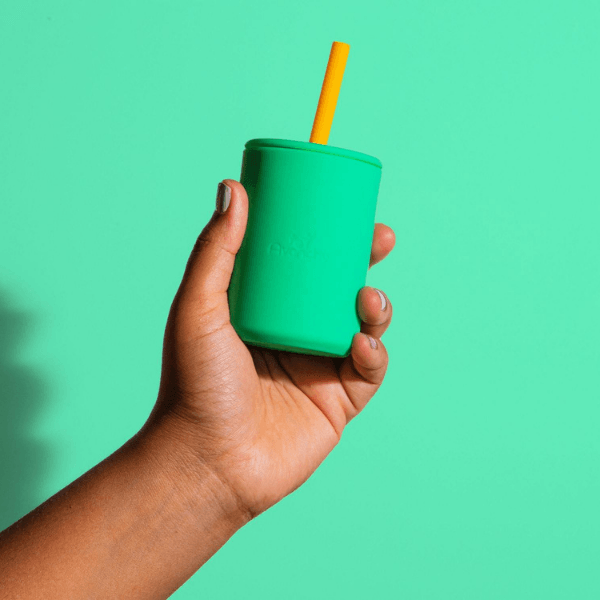BLACK FRIDAY Up to 60% OFF SALE!
BLACK FRIDAY Up to 60% OFF SALE!
Feeding Essentials

The Basics of Teaching Your Toddler To Drink From an Open Cup
October 29, 2021 5 min read
Drinking from an open cup is a big early milestone for your baby. While the learning process comes with its share of mishaps and messes, mastering the open cup is a rewarding experience for both you and your little one. If you’re nervous about getting started, don’t worry! Stay calm, let your baby lead the way, and learn to adjust as you go. With these basics of teaching your toddler to drink from an open cup, you can navigate the process and succeed on this journey together.
When Is Your Baby Ready?
Introducing your baby to an open cup goes hand in hand with introducing them to solids. This usually happens around six to eight months, but remember that every child progresses differently. As you start experimenting with soft finger foods, give them a cup with a little bit of water, milk, or formula in it.
Six- to twelve-month-old babies are interested in learning new things, so this is the perfect time to build habits and practice new skills. Remember that this period isn’t for perfecting the open cup and completely replacing the bottle. Take your time and let your baby get comfortable with cups so that they’re ready to transition when the time comes.
Transition With a Straw Cup
If you’re looking for a middle step between the bottle and the open cup, a straw cup is the best way to go. Straws and lids help you avoid mess as your baby learns to grip the cup and take drinks themselves. Straw cups are a safe and easy way to let your little one get a feel for handling a cup on their own. Plus, when they’re ready for an open cup, you can keep the same dish and remove the lid and straw. This makes the transition process as smooth as possible.
Reasons To Skip the Sippy Cup
Sippy cups are popular during this part of the process, but they aren’t always helpful. Unlike straw cups, sippy cups require a unique oral skill that your toddler won’t need later in life. Moreover, it’s not always easy to get liquid out of a sippy cup. Your little one might grow frustrated by the process, making them far more reluctant to keep working toward an open cup.
That’s why we prefer using baby cups with straws and lids. Learning to drink with a straw is a skill your child will continue to use as they grow older. Plus, straw cups are the same shape as open cups, so your little one can get a head start on their drinking skills.
Moving to the Open Cup
Ready to tackle the open cup? Though it might take a while, the process is a lot simpler than you’d think. One of the best ways to teach your baby is to lead by example. When mealtime comes around, sit down with your little one and show them how by drinking from your own cup. Make your movements slow and exaggerated so that your child can catch on to what you do. If they’re hesitant, try offering their cup to them. Once they have a grip on the cup, help gently guide it to their lips so they can drink.
You’ll have spills, especially during the first couple of attempts. Have a towel ready and take mishaps calmly. Messes are a natural part of the learning process, and the better you take them, the easier the experience will be for your baby.
What To Look For in an Open Cup
The right cup makes the learning process easier. Look for dishes that are small enough for baby hands and mouths. These are easier to handle and will lead to fewer spills. Additionally, choose a baby cup made of a soft material that won’t bang on gums or growing teeth. A silicone baby cup is soft, safe, and durable, making it an ideal choice for your little one.
Finally, let’s talk about additional features. Many baby cups come with double handles, weighted bottoms, angled rims, and other features to make drinking easier. All of these extra components are completely optional. If you have a cup that includes them, make sure your baby also gets a chance to use a regular cup. The versatility will help your baby refine their skills and make the transition to a normal cup easier.
Tips for Reluctant Learners
Your little one might not catch on right away for several reasons. Don’t fret yet—everyone learns at their own pace. Take some time to think about what’s holding your child back and let that inform how you respond to the problem. Here are a few reasons why your baby might struggle and ideas for how to fix them.
They’re Not Interested
Sometimes (or a lot of the time), babies have their own agenda. You can’t force them to learn with an open cup if they’re not ready. If your little one shows zero interest in picking up the cup, wait it out a bit longer. You have time. Bring the cup to meals so that they still have it around and can become familiar with it. Your little one will eventually reach for the cup on their own.
They’re Not Hungry
If your child isn’t hungry, they’re far less likely to engage in new things during meals. Try to ease up on midday snacks or move mealtimes to a slightly different time. With a little bit of hunger motivation, your little one might be more interested in eating and drinking independently.
They Want To Be Independent
While some kids want help every step of the way, others prefer more independence. Being too hands-on might make your baby refuse to try drinking from a cup altogether. If your little one is reluctant, try sitting back and letting them have at it. Relax and let them explore on their own. If messes happen, clean up calmly and let them continue to try drinking on their own. Trial and error is a great way for independent toddlers to learn.
Mealtime Is Too Much Pressure
Stubbornness can also come from too much pressure. If your baby isn’t having it during mealtimes, try introducing the baby cup in a different setting. Playtime is a great opportunity to try drinking. Once again, capture your baby’s interest and take a drink yourself so that you can lead by example. Instead of offering the cup, engage with your little one until they reach for it themselves. If you don’t want to spill in the living room or playroom, try doing this during outside playtime or even during bath time to make clean-up easier.
Knowing the basics of teaching your toddler to drink from an open cup is just the beginning. Like any skill, this process takes practice. Be patient, attentive, and flexible. Let your little one lead the way, and they’ll show you what they need to make this learning journey a success.

Subscribe
Sign up to get the latest on sales, new releases and more …










